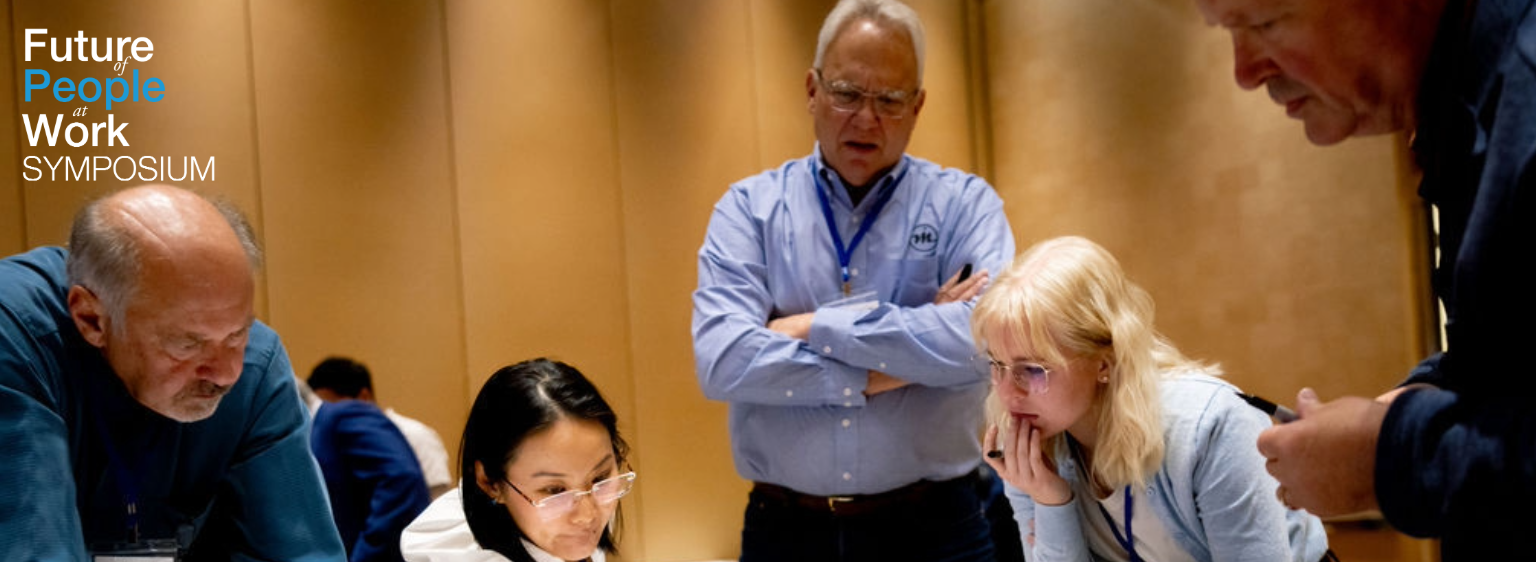By Future of People at Work Symposium Participants and Claude AI*
When Peter Ward, chair of the Lean Enterprise Institute board, challenged the symposium organizers to create truly useful output from the event, Eric Olsen proposed an unconventional solution: using AI to generate the proceedings. What began as an experiment in efficiency would ultimately demonstrate the transformative potential of AI in knowledge capture and synthesis.
The Challenge
Anyone who has attended professional conferences knows the familiar pattern: weeks or months after the event, a hefty document arrives, often too late and too dense to be practically useful. “Typical conference output is late and limited,” notes Olsen. “We wanted to experiment with using AI to create more timely, comprehensive, and useful documentation.”
Traditional proceedings face numerous challenges beyond just delayed publication. They often miss the richness of informal discussions, suffer from inconsistent documentation across sessions, and require intensive resources to compile. Perhaps most importantly, they frequently end up being more archival than actionable.
The Process: A Multi-Stream Approach
The experiment utilized Claude.AI from Anthropic to process what Olsen describes as “a firehose of information” from multiple streams. Visual documentation included hundreds of Post-it notes from discussion sessions, flip charts from group exercises, presentation slides, and photos of workshop outputs. Text-based content ranged from pre-symposium website materials to pre-reading documents and participant information. Additionally, audio recordings from sessions, panel discussions, and group report-outs were transcribed for processing.
Developing the AI Workflow
Rather than dumping all this information into the AI system at once, the team developed a structured approach that proved crucial to the project’s success. “We learned quickly that Claude.AI works best when given information in digestible chunks,” Olsen explains. “We’d process 20-30 Post-it notes at a time, maintaining chronological order and allowing for cross-referencing.”
The workflow evolved into four main phases:
- Data Preparation: Converting various content types into AI-readable formats
- Sequential Processing: Working through materials in logical chunks
- Content Synthesis: Identifying themes and connecting related discussions
- Review and Refinement: Human oversight and quality control
Results That Exceeded Expectations and a Key Learning
The experiment yielded surprising results. Beyond producing a comprehensive 132-page proceedings document, the AI system proved remarkably adept at capturing both formal presentations and informal discussions. “What really impressed us,” Olsen notes, “was the AI’s ability to identify patterns and connections across different sessions that we hadn’t initially noticed ourselves.”
However, an important lesson emerged when sharing the proceedings with the leaders of the seven lean sponsoring organizations: just because you can generate a comprehensive proceedings document doesn’t mean you should. Although impressive in its scope and detail, the 132-page proceedings proved somewhat unwieldy even for symposium participants. This realization led to what would become perhaps the most valuable outcome of the experiment: the creation of a focused seven-article series as the primary output of the symposium.
“The AI helped us see that we needed to make the insights more accessible,” reflects Olsen. “While having a detailed record was valuable, breaking the key themes into focused articles allowed us to share the symposium’s insights in a more engaging and practical format.” The resulting article series (first, second, third, fourth, and fifth) covered key themes including AI integration, workplace evolution, societal applications of lean, and attracting next-generation practitioners. The first article, skillfully written by Tonya Vinas, provided a human foundation that the AI-assisted articles would build upon.
The time savings were substantial, but perhaps more important was the quality and consistency of the documentation across both the proceedings and the article series. The AI maintained a consistent style throughout while ensuring balanced representation of different voices and perspectives.
Lessons From the Experiment
While the AI proved highly capable at processing and synthesizing information, the experiment revealed important insights about the human role in AI-assisted documentation. Context verification, nuance interpretation, and strategic content organization still required human oversight. However, the AI excelled at rapid processing, pattern identification, and maintaining consistency across large volumes of content.
One unexpected learning was the conversational nature of working with Claude.AI. “Although we developed systematic approaches,” Olsen shares, “the AI system was remarkably flexible and accommodating of human inconsistency. The ease of experimentation and correction allowed for both computer and human learning throughout the process.”
Looking to the Future
The success of this experiment opens up exciting possibilities for conference documentation and beyond. Imagine real-time proceedings generation during events, personalized content summaries for different audiences, or automated capture of organizational learning and best practices. Perhaps most importantly, it demonstrates how AI can help distill complex discussions into more focused, accessible formats that reach a broader audience.
Practical Recommendations
For organizations interested in implementing similar AI-assisted documentation projects, preparation is key. Clear objectives, defined data capture standards, and structured prompting strategies provide a foundation for success. During implementation, using multiple data sources and maintaining regular human oversight ensures comprehensive and accurate documentation. The review process should include subject matter experts and focus on both factual accuracy and content balance.
Conclusion
The Future of People at Work Symposium’s AI-assisted proceedings experiment demonstrates the potential to transform how we capture and share knowledge from professional events. “This wasn’t just about using AI to process information faster,” reflects Olsen. “It was about exploring how AI can help us create more valuable, accessible, and actionable documentation of important professional discussions.”
The success of this experiment suggests that AI-assisted documentation could become a standard tool for conference organizers, potentially transforming how we capture and share professional knowledge in the future. For those interested in exploring this approach, Olsen’s advice is simple: “Give it a try! The technology is surprisingly accessible and forgiving. The key is to start small, experiment, and learn from the process.”
The journey continues at the second Future of People at Work Symposium, to be held June 26-27, 2025, hosted by O.C. Tanner in Salt Lake City, Utah. This commitment to ongoing collaboration and learning underscores the community’s dedication to continuous improvement, not just in their individual practices, but in how they come together to shape the future of work.
To stay informed about upcoming Future of People at Work activities, including the 2025 symposium and monthly community meetings, register here.
*This series is the product of a novel collaboration between human insight and artificial intelligence. Content is derived from the collective contributions of the 150 attendees of the Future of People at Work Symposium, processed and structured by Claude.AI 3.5 Sonnet, and curated by Eric O. Olsen, Director – Central Coast Lean, one of the Symposium collaborating organizations. Special thanks to Matt Savas, Beau Keyte, Dave Ostreicher, and Rachel Reuter for adding their expertise as the human editorial board for this entire series.
Future of People at Work Symposium
This unique event brings together practitioners, leaders, and thought pioneers to shape the future of work through collaborative problem-solving and shared learning.




